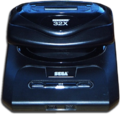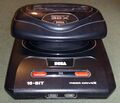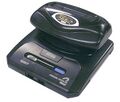Andlabs/Sega 32X
From Sega Retro
The Sega 32X (marketed under regional variant names like Sega Mega Drive 32X (Europe), Sega Super 32X (Japan), and Sega Genesis 32X (USA)) is an accessory for the Sega Mega Drive that allows players to play not only normal Mega Drive games but also specially created 32X games that take advantage of its features. It was developed by a team of engineers at Sega of America while Sega of Japan was busy with the Sega Saturn. During development it was codenamed Mars; this codename remains in several places in several 32X games.
The 32X fits into the cartridge slot of a Mega Drive, but will not fit snugly without a spacer (and in the case of a Mega Drive 1, additional prongs). It also needs to have the Mega Drive's TV output connected to an input port on the back of the 32X (and again, the Mega Drive 1 needed a different cable from the Mega Drive 2), and because the power supplied to the cartridge port is insufficient to power the unit, an extra power cable is needed.
???????????????????????????????????????????????????????????? (history)
However, the 32X was an infamous failure. Manufacturing errors plagued early models, and many games were rushed out the door to get a chance to sell, meaning few games were of very high quality; in particular, very few of the 3D games on the 32X were very good, though that may be justified in that the 3D renderer had to be written entirely from scratch in software (as there was no 3D hardware) and there was very little time to do so. Furthermore, early advertising focused on the system being an arcade at home — exactly what the Mega Drive was originally advertised at — but very few ports of arcade games of the time were made.
The Sega Saturn had already been released in Japan and the 32X was released the same day Sony's PlayStation was (3 December 1994), so the 32X got zero attention there — receiving only 18 games before Sega of Japan pulled the plug on the Mega Drive altogether. Internationally, the 32X fared much better, receiving most of its eventual library in both the US and Europe (with some exclusives in between) plus a series of retooled Sega CD games that took advantage of the 32X's capabilities (see Sega Mega CD 32X).
Hardware
Many myths spread about the 32X's hardware capabilities. The truth:
- The 32X does NOT have 3D rendering hardware — that must all be done in software
- The 32X does NOT have a custom sound setup, QSound, etc. — the 32X has stereo PWM, nothing else (but this was still not easy to work with, resulting in most games not taking advantage of the audio capabilities)
Here is the actual 32X hardware:
- Two Hitachi SuperH-2 CPUs — both model SH7095 at ??
- Talk about shared RAM and cache
- Graphics: custom Sega chip containing two swappable framebuffers (one active at once)
- Rather than having each framebuffer be a typical grid of pixels, Sega has each framebuffer be a series of pointers to pixel data — each pointer refers to a line on screen
- ????????????????????????????????????????????????
- Sound: custom Sega chip containing PWM audio streaming
- ??????
- Output is fed through audio mixer in pins on the Mega Drive cartridge slot — you can disconnect the MD-32X link cable and plug the MD in directly to the TV and still hear 32X audio
- ????????????????????????????????????????????????????????????
Gallery
Physical Scans
- 32X BR Box Front.jpg
BR retail box (front)
- 32X BR Box Back.jpg
BR retail box (back)




















